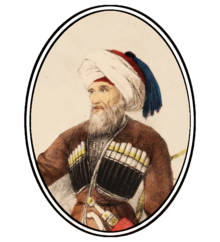|
Kizbech Tughuzhuqo
 Hajji Kizbech Tughuzhuqo (sometimes misspelled as Ghuz Bek; 1777–1840; Adyghe: ШэрэлIыкъо Тыгъужъыкъо Къызбэч, romanized: Ṩərəl'ıqo Tığujzıqo Qızbəç [ʃaraɬʼəqʷa təʁʷəʐəqʷa qəzbatʃ]; Russian: Тугужуко Кызбэч) was a Circassian military commander who took part in the Russo-Circassian War. Personally witnessing all of his family get killed by the Russian army,[2] Tughuzhuqo was a cavalry commander especially successful in raiding behind enemy lines. He received multiple offers from the Russian Empire to switch sides and join its Imperial ranks but he refused all offers and closed negotiations.[3] The Englishman James Bell, who knew him personally, called him "The Lion of Circassia". Biography Early lifeTughuzhuqo was born in 1777 in the village of Beannash, to the Shapsug noble house of Sherelh'yqo. Russo-Circassian WarKizbech started his struggle once the Russo-Circassian War reached western Circassia. Between the years 1810–1840, he stormed the Russian garrisons and settlements with a volley of attacks. In 1821, he defeated a Russian campaign on the lands of Shapsug.[4] In 1830, Kizbech attacked Elizavinskaya settlement and destroyed it, and in 1834, heading a force of 700 cavaliers, he brutally defeated a 14 thousand soldier Russian troops. Again, in the same year, he headed 1200 cavaliers to victory over 6 thousand Russian soldiers.[4] Over many years, he raided several hostile Russian garrisons; Maryanskaya, Georgie, Afepskaya, Apenskaya, and in 1837 while crossing through a field, he was identified by Cossack peasants, who out of their great fear, fled the place leaving behind them 200 sickles. In the same year of 1837, Kizbech stormed the coastal castle of Nikolayev and seized all its properties.[5] In 1837, accompanied by 250 men, he attacked the right bank of the Kuban Russian fort. As a warrior, Tughuzhuqo enjoyed great respect among opponents. Tsarist generals entered into negotiations with him and repeatedly offered him to join the service of Russia, he rejected all offers. After the failure of his generals to convince him, Tsar Nicholas I tried to personally approach Kizbech to dissuade him from continuing his acts. Kizbech rejected offers of money and continued his raids on Russian garrisons. In October 1838, he received seven serious wounds, and his sons were injured and eventually died from the injuries. In 1840, Kizbech, heading a group of Circassian cavaliers, captured the garrisons of Waya, Tuapse and Shaps.[4] Circassian revolutionCircassian revolution started in Shapsug when Kizbech was 18 years old. In this war, the peasants of Shapsug rebelled against their princes. Despite being for the princes' class, Kizbech took the side of the peasants and was one of the few aristocratic figures that were accepted in the new social structure that the Shapsegh had founded. FameBritish adventurer James Bell was impressed by the courage of Kizbech. He witnessed the fear in the hearts of Russian soldiers when hearing Kizbech's name, and how they dispersed before him after they had seen him.[6] Russian General Olshevsky wrote:[7]
DeathKizbech Tughuzhuqo died of wounds received in action on February 28, 1840. He had six different fatal wounds at the time. Some other sources claim he died in battle. LegacyIn 2014, in the 150th anniversary of the end of Russo-Circassian War, a group of Circassian nationalists organized the constructing a monument of Kizbech in the village of Afipsip.[8] As of June 2015 the fundraising was completed and the statue was built.[9] The Republic of Turkey created a postage stamp in memory of Kizbech.[10][11][12] See alsoReferences
External links
|
||||||||||||||||||||||||||||||
Portal di Ensiklopedia Dunia
